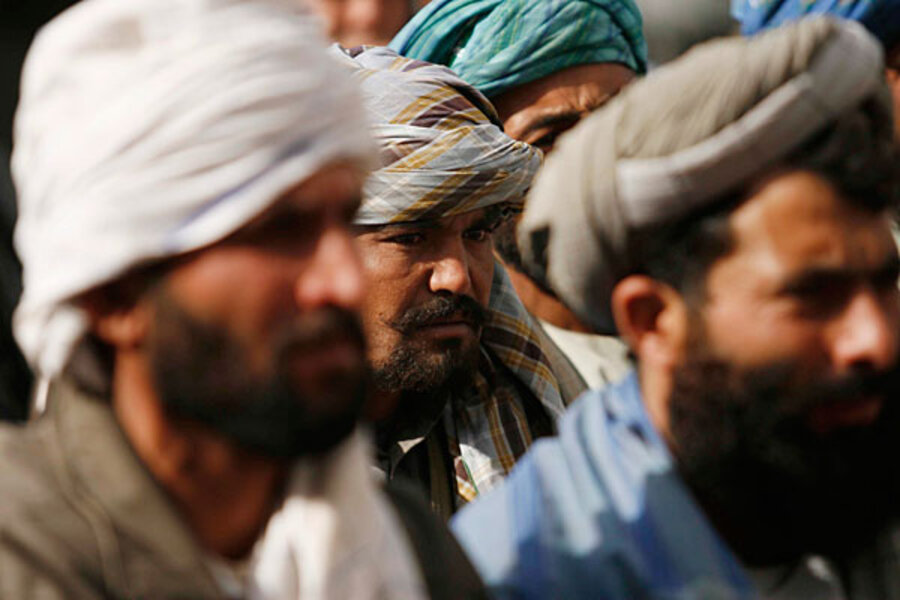How NATO hopes to undercut the Afghan Taliban
Loading...
| Kabul, Afghanistan
With its decision to deploy 30,000 more troops to Afghanistan, the United States is looking to put the Taliban in a more conciliatory mood.
If it can claim more successes on the battlefield, the thinking goes, it can convince more low- and mid-level insurgents to quit under a new NATO program created to win them over. And if it can hollow out this base of fighters and commanders on which Taliban leaders rely, it can improve its bargaining position against them in high-level negotiations.
“In a situation where security is widely perceived to have collapsed and the [Karzai] government is in a more precarious situation, it’s unlikely [Taliban] fence-sitters would opt to jump onto the government side,” says Michael Semple, a regional expert with experience dialoguing with the Taliban.
“So, in the short term, the only people ready to sign on would be the exceptions, where there are some local or personal political reasons,” he says.
The new program, called the Commander Emergency Response Program (CERP), aims to avoid the fate of a previous Afghan-run effort, which wooed rank-and-file Taliban with government jobs but foundered under corruption and a failure to protect defectors.
Over the past five years this effort, the Program for Strengthening Peace and Reconciliation, has brought 8,300 Taliban members to the government side. But the pace has slowed, and foreign donors have yanked funding amid accusations that the PTS (the program is known by its Afghan acronym) has grown too political and corrupt.
For Afghans who joined the Taliban simply because their political rivals had beat them out for a position in the government, the PTS offered a way out. The program would try to flip these “insurgents” and protect them. But sometimes, rivals – now government officials – would not let them return home.
“Inside the structure of government, there are a lot of people who do not want peace,” says Mohammad Akram, the PTS director. As for the Taliban, “always they are asking for [government] positions.”
Another challenge was that the Taliban actively undermined local tribal elders in the south and east, undercutting the intermediaries who could help strike deals and assure defector safety, Mr. Akram says.
CERP will instead award its $1.3 billion (allocated to Iraq and Afghanistan) in village development. By avoiding direct cash payments, it may be less prone to corruption and charges that Western funds are paying off the Taliban.
Taliban cells are organized along village lines, with a commander overseeing several villages, says a military official with knowledge of the program who was not authorized to be quoted. Commanders generally can count on the loyalty of their men, and defections under PTS often came in groups, though it’s unclear if the indirect village payments will provide enough enticement.
NATO hopes that by siphoning off enough low-level fighters it will force Taliban leaders to negotiate from a weaker position. Right now it’s the Taliban who appear more interested in talks – a reflection of their relative strength – while Western officials appear unready.
Divisions among Western officials are complicating talks as well. They disagree about which factions of the insurgency are primarily Pan-Islamist forces committed to global jihad – and too ideological to negotiate with – and which are nationalist forces aiming to reclaim power in Afghanistan. The main groups are the Quetta Shura (the Taliban leadership cell under Mullah Omar), the Haqqani network, and Hizb-e-Islami.
Recent statements from the Quetta Shura suggest the movement has moved toward nationalist aims, says Wahid Mujda, a former Taliban who monitors Taliban statements. “Before this, the Taliban agenda was an international agenda, like Al Qaeda. But now I can say this is a national agenda.”
Any deal would be with elements of the Quetta Shura, says Mr. Semple. The Haqqanis are too aligned with Al Qaeda, and Hizb-e-Islami “brings so little militarily.”
Still, warns Ronald Neumann, former US ambassador to Afghanistan, Western officials should be careful about the intentions of any insurgents expressing willingness to talk. They could be sending such signals because they see it as a useful way to deepen Western divisions about scaling up the war. “I would look very seriously if the motivation to negotiate among the Taliban is to really make peace or to exploit seams," he says.





